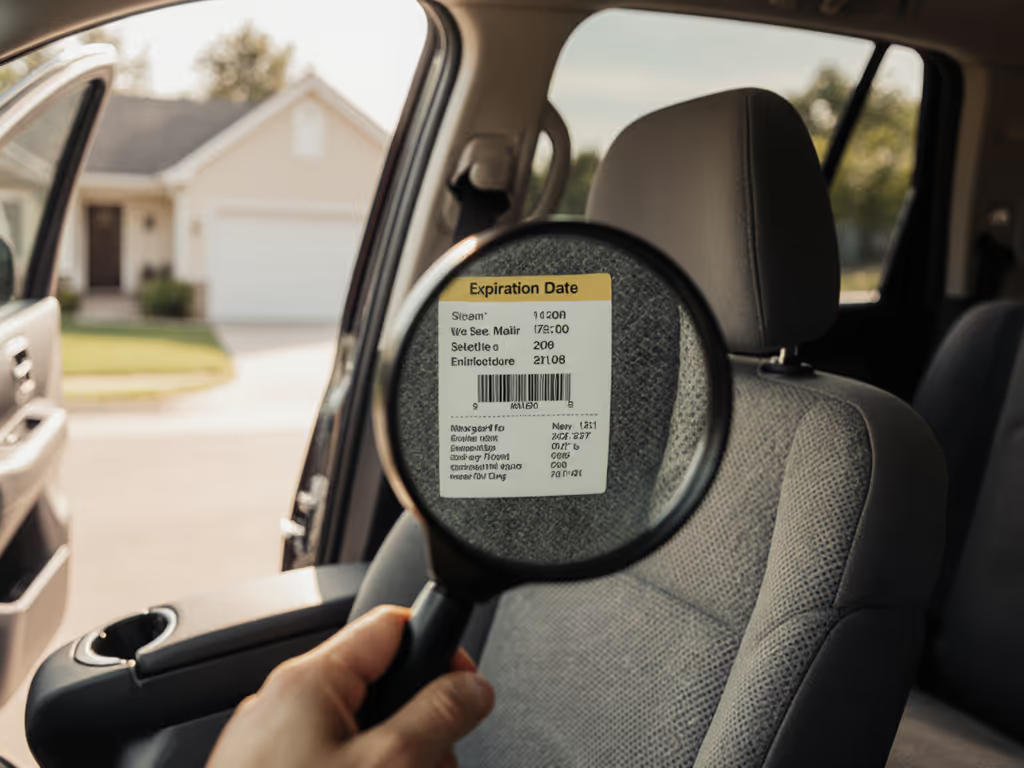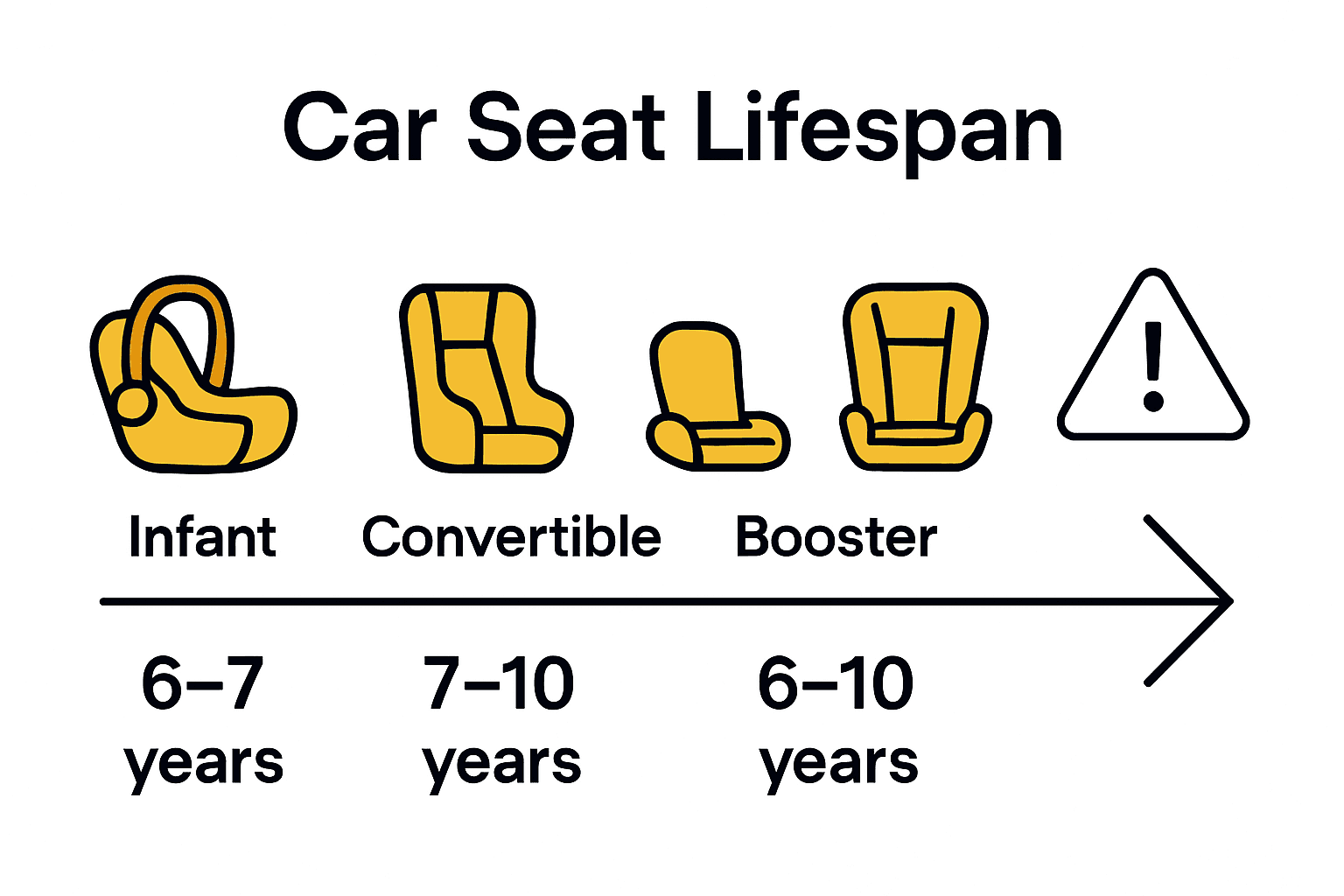
Car Seat Lifespan: Everything You Need to Know

Most parents are surprised to learn that car seats have a strict expiration date, often just 6 to 10 years after manufacture. Many assume a sturdy seat can keep a child safe for decades, yet hidden material wear and evolving safety standards tell a different story. Understanding how long a car seat truly lasts, and why it matters, helps ensure every ride offers real protection for your child—not just peace of mind.
Key Takeaways
| Point | Details |
|---|---|
| Car Seat Lifespan | Car seats typically expire 6-10 years from their manufacture date due to material degradation and evolving safety standards. |
| Check Expiration Dates | Parents should regularly check the manufacturer's label for the car seat's manufacture and expiration dates to ensure safety compliance. |
| Impact of Expiration | Using an expired car seat can significantly compromise safety due to material fatigue, potentially leading to ineffective protection in collisions. |
| Safe Disposal Practices | When disposing of an expired car seat, destroy it to prevent reuse, and consider recycling options through manufacturer programs or local initiatives. |
What Is Car Seat Lifespan
A car seat lifespan is the predetermined period during which a child safety seat remains structurally sound and safe for use. Unlike many baby products that can be handed down through generations, car seats have a specific expiration timeline determined by critical safety considerations. Most manufacturers recommend replacing car seats between 6-10 years after their production date, not purchase date.
The primary reasons for car seat expiration stem from complex material science and safety engineering. Plastic components gradually degrade when exposed to extreme temperature variations, direct sunlight, and regular wear. Material breakdown can compromise the seat's structural integrity, potentially reducing its ability to protect a child during a collision. Think of a car seat like a safety helmet - its protective capabilities diminish over time, even if no visible damage appears.
Research from authoritative sources provides clear guidance on lifespan expectations. The Swedish National Road and Transport Research Institute (VTI) indicates that child car seats generally remain safe for approximately 10 years from manufacture. Similarly, the Washington Post reports that typical car seats expire around six years due to:
- Technological advancements in safety design
- Material degradation from environmental exposure
- Evolving safety standards and regulations
Parents should always check their specific car seat's manufacturer recommendations, as expiration timelines can vary. The manufacture date is typically printed on a label located on the car seat's side or bottom. Tracking this date helps ensure you're using a seat that meets current safety standards and maintains optimal protective capabilities for your child.
Typical Lifespans And Variations
Car seat lifespans are not a one-size-fits-all scenario. Different car seat types have varying recommended usage periods, influenced by design complexity, materials, and intended age range. Infant car seats typically have the shortest lifespan, while convertible and booster seats can remain safe for longer periods, often spanning multiple developmental stages of a child's growth.
Research from the Swedish National Road and Transport Research Institute (VTI) reveals nuanced differences in car seat aging. Infant and rear-facing seats tend to experience more rapid material degradation due to frequent handling and more complex structural requirements. In contrast, booster seats are less susceptible to aging because they have simpler mechanical components and less direct physical stress.
Here's a breakdown of typical car seat lifespans by category:
- Infant Car Seats: 5-6 years
- Convertible Car Seats: 7-10 years
- Booster Seats: Up to 10 years
- All-in-One Car Seats: 10 years
Factors that significantly impact a car seat's usable lifespan include:
- Frequency of use
- Exposure to temperature extremes
- Physical damage or accidents
- Storage conditions
- Manufacturing quality
Parents should treat the manufacturer's recommended expiration date as a critical safety guideline.
 Even if a car seat appears undamaged, material fatigue and potential microscopic structural changes can compromise its protective capabilities. Regular inspection, careful storage, and adherence to manufacturer recommendations are key to ensuring your child's safety during transportation.
Even if a car seat appears undamaged, material fatigue and potential microscopic structural changes can compromise its protective capabilities. Regular inspection, careful storage, and adherence to manufacturer recommendations are key to ensuring your child's safety during transportation.
Why Car Seats Expire
Car seat expiration is not a marketing gimmick, but a critical safety mechanism rooted in scientific understanding of material degradation and evolving safety technologies. The primary reasons behind car seat expiration are complex, involving multiple interconnected factors that directly impact a child's protection during transportation. Unlike other baby products that can be passed down, car seats have a finite functional lifespan due to their critical role in child safety.
The most significant factor in car seat expiration is material science. Plastic components used in car seats are particularly vulnerable to environmental stress. Repeated exposure to temperature extremes - from scorching summer heat to freezing winter cold - causes microscopic structural changes in the seat's polymers. These subtle alterations can compromise the seat's ability to absorb and distribute impact forces during a potential collision, even when no visible damage is apparent.
Research from the Washington Post highlights several key reasons for car seat expiration:
- Technological Advancements: Safety standards continuously improve, rendering older designs less effective
- Material Degradation: Plastic components weaken over time due to UV exposure and temperature fluctuations
- Structural Integrity: Repeated use causes gradual wear that can reduce impact resistance
- Safety Standard Updates: Regulatory requirements evolve, making older seats potentially non-compliant
Beyond material science, car seat manufacturers incorporate expiration dates as a proactive safety measure. Think of it like a safety warranty - after a certain period, they cannot guarantee the seat's optimal performance. The combination of material fatigue, potential unseen damage, and technological improvements means that replacing your car seat within its recommended timeframe is one of the most important safety decisions a parent can make.
Finding And Interpreting Expiration Dates
Locating the expiration date on a car seat requires careful attention to detail. Most manufacturers print this critical information on a sticker or molded label located on the side or bottom of the car seat. The sticker typically includes multiple important pieces of information: the manufacture date, serial number, and the specific expiration date. Parents should treat this information like a safety passport for their child's protective equipment.
Interpreting these dates requires understanding the standard industry practice. Most car seats have a lifespan of 6-10 years from the manufacture date, not the purchase date. This means even if a car seat remains unused in its original packaging, its protective capabilities are considered diminished after the specified period. The Washington Post emphasizes that the manufacture date is the crucial starting point for calculating a car seat's usable lifespan.
Here's a step-by-step guide to finding and reading your car seat's expiration information:
- Check the side of the car seat for a white or colored sticker
- Look for text that includes "Manufactured Date" or "DOA" (Date of Manufacture)
- Verify the printed expiration date or calculate 6-10 years from the manufacture date
- If information is unclear, contact the manufacturer directly
Warning signs that might indicate you need to replace a car seat include:
- Visible cracks in the plastic shell
- Faded or worn fabric
- Missing parts or labels
- Passed the manufacturer's recommended expiration date
Remember, these expiration dates are not suggestions - they're critical safety guidelines designed to protect your child from potential structural failures that might not be visible to the naked eye.
Risks And Safety Implications
Using an expired car seat introduces multiple hidden risks that many parents might not fully comprehend. Structural integrity degradation is the most critical concern, where microscopic material changes can significantly compromise the seat's ability to protect a child during a collision. An expired car seat might look perfectly fine on the surface, but its internal protective capabilities could be dramatically reduced, creating a false sense of security.
Research highlights that material fatigue dramatically impacts a car seat's protective performance. Plastic components undergo molecular-level changes when exposed to repeated temperature fluctuations, UV radiation, and physical stress. These changes can cause brittleness, reduced flexibility, and diminished shock absorption capabilities. A study in Medical Science and Discovery emphasized that many parents lack comprehensive understanding of these nuanced safety implications, underscoring the importance of proactive replacement.
Key risks associated with using an expired car seat include:
- Reduced Impact Absorption: Compromised ability to distribute collision forces
- Material Weakness: Increased likelihood of structural failure during accidents
- Non-Compliance: Potential violation of current safety regulations
- Ineffective Restraint: Decreased protection during sudden stops or collisions
Beyond physical risks, using an expired car seat can have legal and insurance implications. In the event of an accident, insurance companies might challenge claims if a non-compliant car seat was in use. Parents should view car seat replacement not as an optional expense, but as a critical investment in their child's safety - comparable to maintaining functional brakes on a vehicle or replacing worn-out safety equipment.
Disposal And Replacement Guidelines
Responsible car seat disposal is more complex than simply throwing an expired seat in the trash. Parents must take strategic steps to ensure the seat cannot be reused by others and to minimize environmental impact. The goal is to render the seat completely unusable while also being environmentally conscious.
The Swedish National Road and Transport Research Institute (VTI) recommends a comprehensive approach to car seat replacement. Before disposal, parents should thoroughly document the seat's expiration or damage status. This documentation can be helpful for insurance purposes or potential product safety investigations. Recommended disposal steps include physically destroying the seat to prevent potential reuse by unsuspecting individuals who might not understand its compromised safety status.
Here's a systematic approach to car seat disposal:

- Remove and destroy the harness and straps
- Cut the seat cover into multiple pieces
- Break or saw the plastic shell into multiple sections
- Remove and deface the manufacture and model labels
- Separate plastic, metal, and fabric components for appropriate recycling
Alternative disposal options include:
- Manufacturer Recycling Programs: Some brands offer specialized recycling services
- Local Recycling Centers: Check for specialized child safety equipment recycling
- Community Safety Events: Some organizations host car seat exchange or recycling events
When replacing a car seat, prioritize purchasing from reputable manufacturers that meet current safety standards. The Washington Post emphasizes the importance of selecting a new seat that fits your vehicle, matches your child's age and size, and comes with clear manufacture and expiration documentation.
Make Every Mile Safer With the Right Car Seat
Understanding the lifespan of your child’s car seat is crucial to keeping them safe on every trip. This article highlights common concerns like material degradation, safety standard updates, and hidden risks of using expired seats. If you worry about the best time to replace your child's seat or want to avoid unexpected safety compromises, you are not alone. The challenge is finding a convertible car seat that not only fits your vehicle and child properly but also offers long-term reliability and meets evolving safety guidelines.
At Fits for Years Seats, we specialize in helping you navigate these exact concerns. Our expert reviews and buying guides focus on seats designed for lasting use with superior safety compliance such as FMVSS 213. We provide detailed insights on installation ease, comfort, and cost efficiency tailored to your child’s age and size, so you can confidently choose a seat that protects your family now and for years to come. Don’t wait until your seat reaches expiration or compromises safety. Explore our comprehensive resources and find the perfect fit at Fits for Years Seats.
Take control of your child’s safety today. Visit Fits for Years Seats to compare top convertible car seats designed for durability and peace of mind.
Frequently Asked Questions
What is the typical lifespan of a car seat?
Most car seats have a lifespan of 6-10 years from the manufacture date, depending on the type of seat. Infant car seats typically last 5-6 years, while convertible and booster seats can last up to 10 years.
Why do car seats expire?
Car seats expire primarily due to material degradation, exposure to environmental stresses, and evolving safety standards. These factors can compromise the seat's structural integrity and protective capabilities over time.
How can I find the expiration date on my car seat?
To find the expiration date, check for a sticker or label on the side or bottom of the car seat that indicates the manufacture date and the expiration date. If the information is unclear, contact the manufacturer directly.
What should I do with an expired car seat?
When disposing of an expired car seat, remove and destroy the harness and straps, cut the seat cover, break the plastic shell into sections, and deface the labels. This prevents the seat from being reused and ensures safety.




